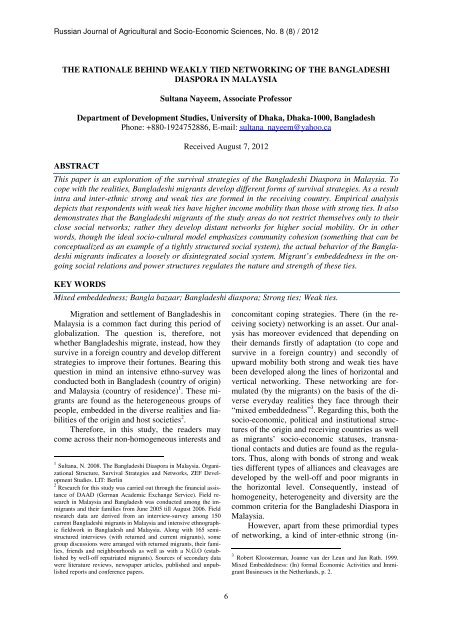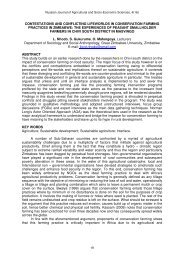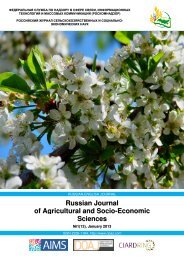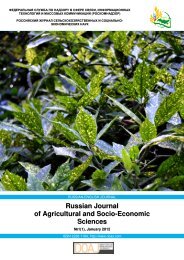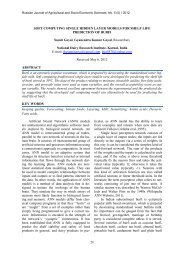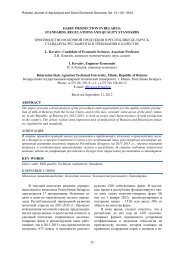Russian Journal of Agricultural and Socio-Economic Sciences ...
Russian Journal of Agricultural and Socio-Economic Sciences ...
Russian Journal of Agricultural and Socio-Economic Sciences ...
You also want an ePaper? Increase the reach of your titles
YUMPU automatically turns print PDFs into web optimized ePapers that Google loves.
<strong>Russian</strong> <strong>Journal</strong> <strong>of</strong> <strong>Agricultural</strong> <strong>and</strong> <strong>Socio</strong>-<strong>Economic</strong> <strong>Sciences</strong>, No. 8 (8) / 2012THE RATIONALE BEHIND WEAKLY TIED NETWORKING OF THE BANGLADESHIDIASPORA IN MALAYSIAABSTRACTSultana Nayeem, Associate Pr<strong>of</strong>essorDepartment <strong>of</strong> Development Studies, University <strong>of</strong> Dhaka, Dhaka-1000, BangladeshPhone: +880-1924752886, E-mail: sultana_nayeem@yahoo.caReceived August 7, 2012This paper is an exploration <strong>of</strong> the survival strategies <strong>of</strong> the Bangladeshi Diaspora in Malaysia. Tocope with the realities, Bangladeshi migrants develop different forms <strong>of</strong> survival strategies. As a resultintra <strong>and</strong> inter-ethnic strong <strong>and</strong> weak ties are formed in the receiving country. Empirical analysisdepicts that respondents with weak ties have higher income mobility than those with strong ties. It alsodemonstrates that the Bangladeshi migrants <strong>of</strong> the study areas do not restrict themselves only to theirclose social networks; rather they develop distant networks for higher social mobility. Or in otherwords, though the ideal socio-cultural model emphasizes community cohesion (something that can beconceptualized as an example <strong>of</strong> a tightly structured social system), the actual behavior <strong>of</strong> the Bangladeshimigrants indicates a loosely or disintegrated social system. Migrant’s embeddedness in the ongoingsocial relations <strong>and</strong> power structures regulates the nature <strong>and</strong> strength <strong>of</strong> these ties.KEY WORDSMixed embeddedness; Bangla bazaar; Bangladeshi diaspora; Strong ties; Weak ties.Migration <strong>and</strong> settlement <strong>of</strong> Bangladeshis inMalaysia is a common fact during this period <strong>of</strong>globalization. The question is, therefore, notwhether Bangladeshis migrate, instead, how theysurvive in a foreign country <strong>and</strong> develop differentstrategies to improve their fortunes. Bearing thisquestion in mind an intensive ethno-survey wasconducted both in Bangladesh (country <strong>of</strong> origin)<strong>and</strong> Malaysia (country <strong>of</strong> residence) 1 . These migrantsare found as the heterogeneous groups <strong>of</strong>people, embedded in the diverse realities <strong>and</strong> liabilities<strong>of</strong> the origin <strong>and</strong> host societies 2 .Therefore, in this study, the readers maycome across their non-homogeneous interests <strong>and</strong>1 Sultana, N. 2008. The Bangladeshi Diaspora in Malaysia. OrganizationalStructure, Survival Strategies <strong>and</strong> Networks, ZEF DevelopmentStudies. LIT: Berlin2 Research for this study was carried out through the financial assistance<strong>of</strong> DAAD (German Academic Exchange Service). Field researchin Malaysia <strong>and</strong> Bangladesh was conducted among the immigrants<strong>and</strong> their families from June 2005 till August 2006. Fieldresearch data are derived from an interview-survey among 150current Bangladeshi migrants in Malaysia <strong>and</strong> intensive ethnographicfieldwork in Bangladesh <strong>and</strong> Malaysia. Along with 165 semistructuredinterviews (with returned <strong>and</strong> current migrants), somegroup discussions were arranged with returned migrants, their families,friends <strong>and</strong> neighbourhoods as well as with a N.G.O (establishedby well-<strong>of</strong>f repatriated migrants). Sources <strong>of</strong> secondary datawere literature reviews, newspaper articles, published <strong>and</strong> unpublishedreports <strong>and</strong> conference papers.concomitant coping strategies. There (in the receivingsociety) networking is an asset. Our analysishas moreover evidenced that depending ontheir dem<strong>and</strong>s firstly <strong>of</strong> adaptation (to cope <strong>and</strong>survive in a foreign country) <strong>and</strong> secondly <strong>of</strong>upward mobility both strong <strong>and</strong> weak ties havebeen developed along the lines <strong>of</strong> horizontal <strong>and</strong>vertical networking. These networking are formulated(by the migrants) on the basis <strong>of</strong> the diverseeveryday realities they face through their“mixed embeddedness” 3 . Regarding this, both thesocio-economic, political <strong>and</strong> institutional structures<strong>of</strong> the origin <strong>and</strong> receiving countries as wellas migrants’ socio-economic statuses, transnationalcontacts <strong>and</strong> duties are found as the regulators.Thus, along with bonds <strong>of</strong> strong <strong>and</strong> weakties different types <strong>of</strong> alliances <strong>and</strong> cleavages aredeveloped by the well-<strong>of</strong>f <strong>and</strong> poor migrants inthe horizontal level. Consequently, instead <strong>of</strong>homogeneity, heterogeneity <strong>and</strong> diversity are thecommon criteria for the Bangladeshi Diaspora inMalaysia.However, apart from these primordial types<strong>of</strong> networking, a kind <strong>of</strong> inter-ethnic strong (in-3 Robert Kloosterman, Joanne van der Leun <strong>and</strong> Jan Rath. 1999.Mixed Embeddedness: (In) formal <strong>Economic</strong> Activities <strong>and</strong> ImmigrantBusinesses in the Netherl<strong>and</strong>s, p. 2.6


